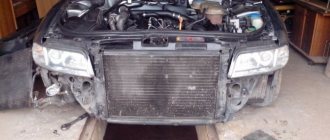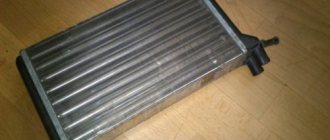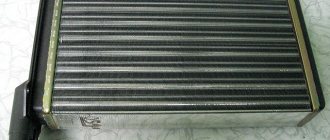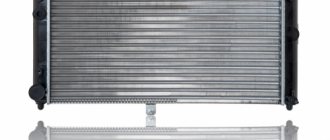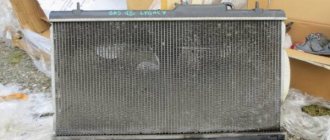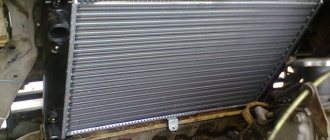There are two types of malfunction symptoms in the cooling system of a car engine: the engine slowly reaches operating temperature or quickly overheats. One of the simplest methods of rough diagnosis is to check with your hand the degree of heating of the upper and lower radiator pipes.
Below we will look at why the internal combustion engine cooling system may not work well and what to do in such situations.
The cooling system (VAZ Lada Kalina) includes a number of functional elements:
- Engine cooling radiator. This unit is designed to reduce the temperature of heated antifreeze using a cold air flow.
- Radiator fan. This part performs the function of increasing the intensity of coolant cooling () in the system.
- Heater radiator. This is essentially a source of warm air for the car interior.
- Expansion tank. Since coolant tends to expand and contract with constant temperature fluctuations, this container serves to compensate for the volume of antifreeze in the system.
- Centrifugal pump or “pump”. This element carries out forced circulation of coolant through the channels of the vehicle system.
- Thermostat. This small, seemingly primitive part, performs a very important function: it regulates the required amount of antifreeze passing through the engine cooling radiator. Thanks to the thermostat, the most optimal temperature regime in the system is ensured.
- Coolant temperature sensor. This is one of the control elements of the ODS.
The engine cooling system diagram (Kalina 2117) is shown in the photo below:
What to do if the lower radiator hose is cold
In most cases, the problem is related to the thermostat. This is potentially the most unreliable element of the system. You can measure the temperature of its pipes using a non-contact digital thermometer, and if the temperature difference exceeds the threshold for the valves to start opening, then the thermostat must be removed and checked, but most likely it will have to be replaced.
The pump impeller fails much less often. This only happens in cases of obvious manufacturing defects. Pumps are also not reliable, but their failure is manifested quite clearly in the form of bearing noise and fluid leakage through the seal. Therefore, they are replaced either prophylactically, based on mileage, or when these very noticeable signs occur.
Other reasons are more difficult to diagnose; it may be necessary to pressure test the system, check it with a scanner, measure the temperature at various points and other research techniques from the arsenal of professional motorists. And most often - taking an anamnesis; cars rarely break down on their own.
Perhaps the car was not looked after, the fluid was not changed, water was added instead of antifreeze, and repairs were entrusted to dubious specialists. The type of expansion tank, the color of the antifreeze in it and the smell will indicate a lot. For example. the presence of exhaust gases means a gasket breakdown.
If the fluid level in the expansion tank suddenly begins to drop, it is not enough to simply top it up. It is necessary to find out the reasons; driving with antifreeze leaking or leaking into the cylinders is strictly forbidden.
The most common causes of coolant leakage from the system are:
- Old clamps on the pipes.
- An old heating radiator or a broken cooling radiator. In the first case, the situation will only be saved by a complete replacement of the device, but in the second, it is quite possible to get by with repairs (soldering the holes).
The next step is to check the coolant circulation in the engine cooling system. To do this, open the cap of the expansion tank and watch how a stream of antifreeze enters it. If the result is unsatisfactory, you need to either change the pump or clean the SOD system (this can be done using special cleaning products).
Quick tests
- Test the cooling system after replacing antifreeze. Cooling is working properly if a jet of coolant flows from the steam outlet pipe of the engine radiator when it is hot at 1,500 rpm. This is clearly visible through the transparent expansion tank (relevant for circulation structures).
- It blows cold on one side of the cabin, and warm on the other. Check the dampers for proper operation and make sure the stove radiator is not clogged.
- The inlet to the heater radiator unit is warm, and the outlet is cold. Either the heat exchanger is clogged or an air lock has formed in it.
- Overheating at idle, sudden temperature changes and cold heater. There are many air pockets in a small circuit.
- Cold engine and furnace radiators. The pump probably failed.
- The heater blows cold, the engine gets warm. Give it over 4,000 rpm. If it gets warmer, look for additional symptoms of a blown head gasket.
If your car begins to overheat frequently, there may be several reasons for this:
Why can the lower radiator hose be cold and the upper hose hot?
There is always a certain temperature difference between the radiator pipes, since this means that part of the energy was sent into the atmosphere. But if, after sufficient heating, one of the hoses remains cold, then this is a sign of a malfunction.
Airlock
The liquid in a normally operating system is incompressible, which ensures its normal circulation by a water pump. If, for various reasons, an airy area has formed in one of the internal cavities - a plug, then the pump will not be able to work normally, and a large temperature difference will arise in different parts of the antifreeze path.
Sometimes it helps to turn the pump up to high speeds so that the plug is expelled into the radiator expansion tank - the highest point of the system - but more often you have to deal with the plugs in other ways.
Most often they occur when the system is filled incorrectly with antifreeze when replacing or topping up. You can bleed air by undocking one of the hoses located at the top, for example, for heating the throttle valve.
Air always collects at the top, it will come out and work will be restored.
It's worse when it's a vapor lock due to local overheating or gas penetration through a broken head gasket. Most likely you will have to resort to diagnostics and repairs.
Coolant pump impeller malfunction
To achieve maximum performance, the pump impeller works to the limit of its capabilities. This means the manifestation of cavitation, that is, the appearance of vacuum bubbles in the flow on the blades, as well as shock loads. The impeller may be completely or partially destroyed.
The circulation will stop, and due to natural convection, hot liquid will accumulate at the top, the bottom of the radiator and the pipe will remain cold. The engine must be stopped immediately, otherwise overheating, boiling and release of antifreeze are inevitable.
The channels in the cooling circuit are clogged
If you do not change the antifreeze for a long time, foreign deposits accumulate in the system, the results of the oxidation of metals and the breakdown of the coolant itself.
Even when replaced, all this dirt will not be washed out of the shirts, and over time it can block the channels in narrow places. The result is the same - cessation of circulation, difference in temperature of the pipes, overheating and activation of the safety valve.
The valve in the expansion tank does not work
There is always excess pressure in the system when heating. This is what allows the liquid not to boil when its temperature, when passing through the hottest parts of the engine, significantly exceeds 100 degrees.
But the possibilities of hoses and radiators are not limitless; if the pressure exceeds a certain threshold, then explosive depressurization is possible. Therefore, a safety valve is installed in the cap of the expansion tank or radiator.
The pressure will be released, the antifreeze will boil and be thrown out, but no major damage will occur.
If the valve is faulty and does not hold pressure at all, then when the antifreeze passes near the combustion chambers with their high temperature, local boiling will begin.
In this case, the sensor will not even turn on the fan, because the average temperature is normal. The situation with steam will exactly repeat the one described above, circulation will be disrupted, the radiator will not be able to remove heat, and the temperature difference between the pipes will increase.
Thermostat problems
The thermostat may fail when its active element is in any position. If this happens in the warm-up mode, then the liquid, having already heated up, will continue to circulate in a small circle.
“Lada Kalina” and an airlock: how to remove airlock?
The first step is to open the expansion tank cap. Next, start the engine and, periodically pressing the gas pedal, warm up the engine until the temperature gauge rises to the red scale. After turning on the fan, give it a little more gas and turn off the ignition. If the airlock cannot be eliminated in this way, you will have to move on to more radical measures.
How is this done? First, the plastic engine screen is removed (it can be removed with a simple upward movement). Next, use a screwdriver to loosen the clamp, and remove one of the two tubes from the throttle assembly heating fitting. Then the cap of the expansion tank is unscrewed. Cover the neck of the container with a clean rag. Next, you need to blow into the expansion tank until coolant flows out of the removed tube. If you are unable to break through the container, close the lid and put back the throttle assembly tube. Next, you need to warm up the engine again and turn off the ignition. After this, without removing the cap from the tank, remove the heating tube again and wait until antifreeze flows out of it under pressure.
Since this liquid is very toxic and poses a certain danger to humans, experts recommend draining the coolant with extreme caution. Don't forget about safety precautions: at a minimum, you should have a pair of rubber gloves. Also monitor the temperature of the tubes; draining the coolant should only be done when the engine has cooled down.
Now put the tube on the fitting and tighten the clamps. At this stage, the air in the cooling system (Kalina, VAZ) has been successfully removed. As you can see, troubleshooting in the ODS can be done without involving specialists.
In the future, in order to prevent similar malfunctions of the cooling system, the Lada Kalina should be regularly diagnosed for the tightness of all clamps and connections in the system.
Causes of a cold Kalina stove
A car is a complex unit that uses a huge number of different parts and mechanisms that work in tandem with each other; failure of one of the parts can lead to serious consequences in the operation of the car. You can judge the Lada Kalina stove in the same way: in order for the stove to function correctly and efficiently, all its parts and mechanisms must be in good working order and work correctly.
Causes of a cold stove:
- The expander cover is stuck;
- Insufficient amount of antifreeze;
- The radiator is clogged;
- Gear motor failure;
- The engine thermostat is faulty;
Reasons for low flow from the stove:
- The cabin filter is clogged;
- The heater radiator is clogged;
To make it clearer, let's look at each of the reasons in more detail.
Poor circulation of antifreeze or antifreeze in the system
Let us immediately note that in case of poor circulation of antifreeze through the system, a problem with poor heating is the most harmless thing that can happen to a car. Of course, if the stove in a Lada-Kalina car does not heat well, this may be caused by ineffective circulation of antifreeze, but in this case the engine may overheat greatly due to a lack of coolant and low heat removal efficiency. So you need to think about the stove itself secondarily. However, if the thermometer shows normal engine temperature (90-100 degrees), then there is no need to worry.
Cabin filter
Every car has a cabin filter. It is through it that heated air from the stove (or cold air from the air conditioner) enters the cabin. If there were no cabin filter, then debris and dust, and sometimes fat particles (products of oil evaporation, for example) from the engine compartment would fly into the cabin. If this filter hasn't been changed in years, then there is a good chance that it is simply clogged and needs to be replaced. Air simply cannot pass through a dirty filter into the cabin, so it is not surprising that the stove on the Kalina does not heat the air well.
Solving this problem is quite easy: you need to remove the cabin filter and install a new one. It is located under the hood of the car, at the top left (near the front passenger seat). It can be accessed with just one screwdriver, and the cabin filter itself is cheap (its price is about 200 rubles).
squeezes the pipe
Sanderis » November 16, 2013, 00:06 » Message No. 200394
Guys, help! The engine is cooling down and compressing the pipe going to the radiator. What could be wrong?
satiriaz » Nov 16, 2013, 01:19 pm » Message No. 200404
As far as I know, this is how it should be
Yuri » November 16, 2013, 14:43 » Message No. 200411
It shouldn't be this way. Either the valve is not working correctly, or there is no normal flow of liquid from the expander, or the pipe is running out.
Sanderis » November 16, 2013, 16:09 » Message No. 200416
Thanks guys) valve, do you mean thermostat?)
Alexander_01 » November 16, 2013, 16:36 » Message No. 200417
The topic has already been covered from all sides. Yuri listed everything. But most often it is a tired pipe.
X 666 » November 16, 2013, 19:39 » Message No. 200425
The sooner you change the pipe, it is already tired. I have already gone through this, see the link https://mazda-xedos.ru/problema-v-prokladke-golovki-bloka-foto-vt4949.html
Sanderis » November 17, 2013, 14:32 » Message No. 200452
I’ll change the pipe and then we’ll see if the sore goes away or not :-) thank you all for your help :-)
satiriaz » November 17, 2013, 17:50 » Message No. 200454
Damn! And a couple of years ago the service center told me that such a sunken pipe is even good! I’m still happy to drive
kakovkin1234 » November 17, 2013, 19:53 » Message No. 200458
Also check if the small hose going to the expansion tank is clogged. Mine was clogged. To check, remove the cap from the tank and blow. It should be easy to blow through.
valve » November 17, 2013, 19:57 » Message No. 200459
+1 I have the same crap with the pipe. somehow I didn’t even attach much importance to it. There have never been any problems with cooling. The antifreeze doesn't seem to go away.
Alexander_01 » November 18, 2013, 15:21 » Message No. 200468
Yes, this is not a problem at all. Just the answer to why it shrinks. He's tired. I don’t remember that members of the forum were torn from old age.
X 666 » 18 Nov 2013, 17:53 » Message No. 200474
It will definitely not burst, but the coolant from the expansion tank may not be tightened; because of this, I overheated the engine once.
DervishVit » November 19, 2013, 10:39 » Message No. 200495
I was torn when gas was leaking from under the gasket. I was lucky that it broke at the top and some liquid leaked out.
Alexander_01 » November 19, 2013, 15:16 » Message No. 200503
